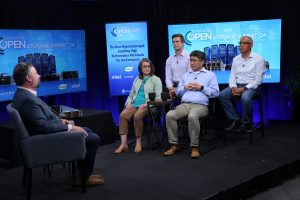 AI
AI
 AI
AI
 AI
AI
As enterprises continue to harness generative artificial intelligence, two stakeholder technologies will shape the ongoing boom: cloud and hyperconverged infrastructure. Winning gen AI at scale combines many factors, from performance to scalability and cost-effectiveness, and modern HCI is rapidly emerging as key to staying competitive on all three fronts.

Unpacking modern HCI with experts from Supermicro, Nutanix, Intel and Western Digital.
“As you add more server nodes into this network, you’re adding more computing and storage capacity,” said Wendell Wenjen (pictured, front row, right), director of storage market development at Super Micro Computer Inc. “It’s a great infrastructure for the enterprise. It really allows the easy delivery of capacity and the management of those systems. We at Super Micro have been working for many years with Intel, Nutanix and Western Digital on developing and deploying and enabling customers to use those solutions.”
In a panel discussion, Wenjen and Christine McMonigal (front row, left), director of hyperconverged marketing at Intel Corp.; Oscar Wahlberg (back row, left), senior director of product management at Nutanix Inc.; and Praveen Midha (back row, right), director of segment and technical marketing of data center flash at Western Digital Corp., spoke with theCUBE Research’s Rob Strechay at the Supermicro Open Storage Summit series, brought to you by Supermicro, Intel, AMD and Nvidia, during an exclusive broadcast on theCUBE, SiliconANGLE Media’s livestreaming studio. They discussed modern HCI as it integrates compute, storage and networking into a single platform, enabling enterprises to meet the demands of modern workloads, driving innovation and enabling next-gen AI apps. (* Disclosure below.)
Originally designed as a scale-out storage solution, HCI’s evolution extended to managing virtual desktops and, eventually, to a broader range of applications — including mission-critical workloads. This constant evolution has been driven chiefly by hardware and software advancements by companies such as Nutanix.
“We started leveraging newer network technologies like RDMA, for example, for offloading essentially CPU cycles to networking cards so that we could free up more CPU to the user VMs,” Wahlberg said. “Then the SSD revolution came in, and we started using all-flash systems to drive the performance even higher. That in turn forced us to rethink some of our storage layers to make sure that we drove those SSDs the best way possible.”
As AI and machine learning become integral to enterprise operations, the role of HCI in supporting these technologies has grown. The introduction of solutions such as Nutanix’s GPT-in-a-Box demonstrates how HCI can provide turnkey solutions for AI workloads, making it easier for enterprises to deploy and manage these complex applications, Wahlberg added.
With the increased complexity and larger dataset requirements of AI models, the need for high-performance, scalable storage solutions is crucial. Western Digital’s approach to the AI data cycle involves optimizing storage for different stages, from cold storage to real-time inference.
“AI is about data utilization and data processing,” Midha said. “As we try to peel the onion, we are finding out that AI is actually only as interesting or as complete as the data underlying is. It creates a virtuous cycle of large sets of data helping us build more meaningful models.”
In the initial stages of AI data processing, high-capacity hard disks are often used for cold storage. As the data is prepared and ingested, SSDs take over, offering the performance needed for sequential data processing. During the model training phase, high-performance SSDs, including those based on PCIe Gen 5 form factors, are essential for handling the demanding workloads, Midha added.
Typically, organizations will take a cloud-native HCI approach to building gen AI applications, deploying retrieval-augmented generation and inference workloads in model training. Intel’s goal is maximizing customer value from data centers and hybrid cloud investments. Intel collaborates with partners such as Nutanix to develop end-to-end solutions, benchmarking different configurations to provide guidance on how to best run critical workloads on modern HCI rigs, according to McMonigal.
“The edge is a very popular place to deploy HCI, because you’ve got compute and storage being deployed together, being able to manage those together and deploy remotely as well if you don’t have IT staff on site,” she said. “The shift that I’m seeing in edge is that people want even more capable infrastructure at the edge to be able to run those analytics and AI workloads locally.”
HCI’s ability to integrate compute and storage in a single platform makes it an ideal solution for edge deployments, where space, power and cooling are often limited.
In addition to edge deployments, Intel is also looking at how HCI can support the sustainability goals of enterprises. By consolidating compute and storage resources, HCI can help reduce the environmental footprint of data centers, contributing to net-zero initiatives, McMonigal added.
“When you’ve got that management plane that enables a single pane of glass to manage your workloads regardless of the environment, having that consistent software and hardware infrastructure layer gives you that flexibility to move and place your workloads wherever it makes the most sense for the business,” she said.
Here’s the complete video interview, part of SiliconANGLE’s and theCUBE Research’s coverage of the Supermicro Open Storage Summit series:
(* Disclosure: TheCUBE is a paid media partner for the Supermicro Open Storage Summit event. Neither Super Micro Computer Inc., the sponsor of theCUBE’s event coverage, nor other sponsors have editorial control over content on theCUBE or SiliconANGLE.)
Support our mission to keep content open and free by engaging with theCUBE community. Join theCUBE’s Alumni Trust Network, where technology leaders connect, share intelligence and create opportunities.
Founded by tech visionaries John Furrier and Dave Vellante, SiliconANGLE Media has built a dynamic ecosystem of industry-leading digital media brands that reach 15+ million elite tech professionals. Our new proprietary theCUBE AI Video Cloud is breaking ground in audience interaction, leveraging theCUBEai.com neural network to help technology companies make data-driven decisions and stay at the forefront of industry conversations.